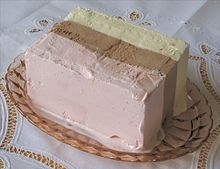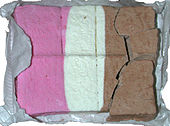Neapolitan ice cream
 Block of Neapolitan ice cream | |
| Alternative names | Harlequin ice cream |
|---|---|
| Place of origin | Italy |
| Main ingredients | Vanilla, chocolate, and strawberry ice cream |
| Variations | Historically, colours were of the Italian flag: green (pistachio or almond), white (vanilla), and red (cherry, actually pink)[1] |
Neapolitan ice cream, sometimes known as harlequin ice cream,[2] is a flavor of ice cream made up of three separate flavored blocks of vanilla, chocolate, and strawberry ice cream side by side in the same container (typically with no packaging in between). Some brands intermix the flavors more, though the separate flavors are still clearly visible.
In Ireland, HB, the most popular brand, uses Vanilla, Strawberry and Lemon flavour ice creams. [3]
Neapolitan ice cream was named in the late 19th century as a reflection of its presumed origins in the cuisine of the Italian city of Naples, and the many Neapolitan immigrants who brought their expertise in frozen desserts with them to the United States. Spumoni were introduced to the United States in the 1870s as Neapolitan-style ice cream. Early recipes used a variety of flavors; however, the number of three molded together was a common denominator, to resemble the Italian flag (cf. insalata tricolore). More than likely, chocolate, vanilla, and strawberry became the standard for the reason that they were the most popular flavors in the United States at the time of introduction.[4]
The first recorded recipe was created by head chef of the royal Prussian household Louis Ferdinand Jungius in 1839, who dedicated the recipe to Fürst Pückler.[5]
Quotes from food historians
"Cosmopolitan slice. A slice of ice-cream cake made with mousse mixture and ordinary ice cream, presented in a small pleated paper case. Neapolitan ice cream consists of three layers, each of a different colour and flavour (chocolate, strawberry, and vanilla), moulded into a block and cut into slices. Neapolitan ice-cream makers were famous in Paris at the beginning of the 19th century, especially Tortoni, creator of numerous ice-cream cakes."[6]
"Eighteenth century... confectioners' shops [were] very often run by Italians. Consequently ice creams were often called "Italian ice creams" or "Neapolitan ice creams" throughout the nineteenth century, and the purveying of such confections became associated with Italian immigrants."[7]
"Neapolitan ice cream, different flavoured layers frozen together....[was] being first being talked about in the 1870s."[8]
A cultural reference from The New York Times in 1887:"...in a dress of pink and white stripes, strongly resembling Neapolitan ice cream."[9]
19th century descriptions

1885 – "Neapolitan box"
"You must have a Neapolitan box for this ice and fill it up in three or four layers with different coloured and flavoured ice creams (a water ice may be used with the custards); for instance, lemon, vanilla, chocolate and pistachio. Mould in the patent ice cave for about 1½ to 2 hours, turn it out, cut it in slices, and arrange neatly on the dish, on a napkin or dish-paper."[10]
1894 – "Neapolitan Icey Cones"
"These are prepared by putting ices of various kinds and colors into a mold known as a Neapolitan ice box, which, when set and turned out, is cut into slices suitable for serving. However small the pieces, the block should be cut so that each person gets some of each kind. They are generally laid on a lace paper on an ice plate. Four or five kinds are usually put in the mold, though three sorts will do. The following will serve as a guide in arranging: First, vanilla cream, then raspberry or cherry or currant water; coffee or chocolate in the middle; the strawberry cream, with lemon or orange or pineapple water to finish. A cream ice flavored with any liqueur, a brown bread cream flavored with brandy, with a couple of bright-colored water ices, form another agreeable mixture. Tea cream may be introduced into almost any combination unless coffee were used. Banana cream, pistachio, or almond cream with cherry water and damson or strawberry water are other options.

"The Neapolitan Ice Spoon has a double use; ice bowl is for putting the mixture into the mold, and the handle is for leveling it. The boxes may be made of tin, which is less expensive than pewter. They are generally sold small enough to make single ices, but these are much more troublesome to prepare. After filling the molds, if there is no cave, 'bed' the ice in the usual way."[11]
Cake
In Australia there is a popular cake known as Neapolitan cake or marble cake, made with the same three colors of Neapolitan ice cream swirled through in a marble pattern, usually topped with pink icing.
See also
Notes
- ^ "This is popularly known as a mixture of creams moulded together, as vanilla, strawberry, and pistachio." Ida C Bailey Allen (1929). Mrs. Allen on Cooking, Menus, Service. Garden City NY: Doubleday, Doran & Company. p. 691.
- ^ Kalil, Frederick (17 September 2012). "We all scream for..." Tufts Now. Medford, Massachusetts: Tufts University. Retrieved 2 December 2014.
- ^ http://www.hbicecream.ie/Products/ProductDetail.aspx?bid=87380&sid=87030&pid=86855
- ^ Jeri Quinzio,Geraldine M. Quinzio. "books.google.ru "Of Sugar and Snow: A History of Ice Cream Making"". Retrieved 2015-06-22.
- ^ Jungius, Louis Ferdinand (1839). Vollständige und umfassende theoretisch-praktische Anweisung der gesamten Kochkunst. Berlin: G. Reimer.
- ^ Lang, Jenifer Harvey (1988). Larousse Gastronomique. New York: Crown. p. 718. ISBN 0-517-57032-7.
- ^ Mariani, John F. (1999). The Encyclopedia of American Food and Drink. New York: Lebhar-Friedman. p. 163. ISBN 0-86730-784-6.
- ^ Flexner, Stuart Berg (1979). I Hear America Talking. New York: Simon & Schuster. p. 191. ISBN 0-671-24994-0.
- ^ The New York Times; June 27 (1887). Thespians on a Frolic. p. 8.
{{cite book}}: CS1 maint: numeric names: authors list (link) - ^ Marshall, A. B. (1885). The Book of Ices. p. 18.
- ^ Heritage, Lizzie (1894). Cassell's New Universal Cookery Book. London: Cassell and Company. p. 967.
References
- Olver, Lynne (1999). "Food Timeline – history notes: ice cream & ice". Retrieved April 3, 2006.
